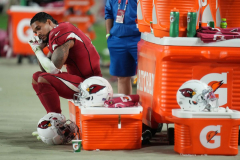
- The Fed is expected to raise its benchmark interest rate again this month by 75 basis points.
- More rate hikes are expected, too, this year as the Fed battles surging inflation.
- Consumers should prepare by locking in fixed rates, refinancing, and paying off high interest debt.
Americans have been bracing for higher borrowing costs, with the Federal Reserve starting an interest rate hiking cycle to stymie soaring inflation.
Investors should expect those higher costs to head ever higher.
The Fed’s policy-making committee meeting ends on Wednesday, and most economists expect the Fed to raise by 75 basis points its benchmark short-term fed funds rate after 12-month June consumer inflation accelerated to a 9.1% pace from 8.6% in May.
Some economists think a full-point rate hike remains a possibility because inflation accelerated in almost every category in June. Last month, the Fed raised rates by 75 basis points, which was the largest one-time increase since 1994, to a range of 1.5% to 1.75%.
Although the Fed doesn’t directly control consumer interest rates, its rate increases ripple through the economy and ultimately, hit businesses and consumers and slow demand and inflation.
“It means your debt is going to get a lot more expensive in a hurry,” says Matt Schulz, chief credit analyst at Lending Tree.
How high will interest rates go?
The Fed’s generally expected to increase rates at every meeting for the rest of this year to get inflation closer to its 2% target.
The hikes, though, may get smaller. ING chief international economist James Knightley expects only 50-basis-point increases in September and November with a final quarter point in December.
Deutsche Bank economists also see a downshift to 50 basis points in September, but said risks are weighted towards a 75-basis-point increase with only two inflation releases slated between the July and September meetings to gauge improvement in inflation trends.
How does this affect my plans to buy a house?
Homeowners with existing fixed-rate mortgages won’t see any changes. But recent and prospective homebuyers are being socked by higher rates that take into account projected Fed increases through much of 2022.
Rates are at a more than 10-year high: June 2009 was the last time the average 30-year, fixed mortgage rate was at or above 5.50%, according to LendingTree.
“The housing market is incredibly rate-sensitive, so as mortgage rates increase suddenly, demand again is pulling back,” Sam Khater, Freddie Mac chief economist, said.
HOUSING SLOWS: Redfin and Compass lay off hundreds of workers as housing market cools, inflation spikes
HOUSE HUNTING TRENDS: Buying a home? How the 2022 housing market could be shifting in your favor
Demand for mortgages and refinances hit a 22-year low last week, Mortgage Bankers Association said.
To put into perspective just how much rising rates can impact borrowers getting a new loan, consider that the average 30-year, fixed mortgage rate on December 30 was 3.11%, 2.43 percentage points lower than the latest average of 5.54% on July 21. On a $300,000 loan, a rate of 3.11% results in a monthly payment of about $1,283, Jacob Channel, senior economist at LendingTree, said.
That same $300,000 loan with a rate of 5.54% results in a monthly payment of $1,711. That’s an extra $428 a month, an extra $5,136 a year, and an extra $154,080 over the 30-year lifetime of the loan, he said.
How do higher interest rates affect the stock market?
Usually, technology and growth stocks are hardest hit by rising interest rates because they rely more on borrowing to fuel their growth.
But with the dual fear of higher rates and recession (or stagflation), more sectors are getting hit this time around. The Standard & Poor’s 500 index officially fell earlier this summer into a bear market, which means the index is down at least 20% from its record high in January.
This prompted investors to buy stocks of companies that make or sell things people must buy, like energy and consumer staples, no matter how the economy fares.
But a recent uptrend in stocks has brought the stock market off its lows and major indices closed higher for two weeks in a row on Friday. Some of that optimism stemmed from better-than-expected forecasts from major companies, but market watchers continue to warn that the economy remains anxious.
“Every day we are getting headlines about the biggest and best-run companies slowing hiring,” Mike O’Rourke, JonesTrading chief market strategist, said. “The only companies to meaningfully rave about business are the airlines, but they keep missing earnings estimates. In this new market regime that severely lacks visibility, we suspect chasing backward-looking earnings will prove to be a mistake.”
TRACKING THE BEAR: We’re in a bear market – again. Here is what that means in seven charts.
LOOKING FOR A BUY: Here are the stocks to buy as the market falls and inflation rises
How do Fed rate hikes affect credit cards?
Credit card interest rates are notoriously among the highest ones you’ll pay with APRs already near record highs, but they’re going even higher. That means your debt is going to keep getting more expensive this year unless you act now.
You should immediately start shopping for a new credit card with a lower rate, experts say.
“These Fed rate hikes don’t just raise APRs on new credit cards,” Matt Schulz, LendingTree chief credit analyst. “The rate you pay on your current balances goes up, too, usually within a billing cycle or two. Any rate increase is unwelcome, but given that we’ve already seen three this year and there’s almost certainly more to come, it should serve as a wake-up call for consumers.”
Other steps you can take include takin





